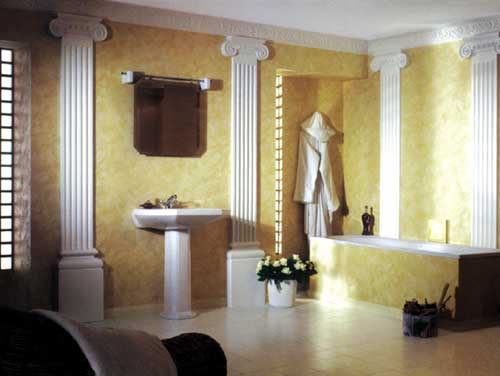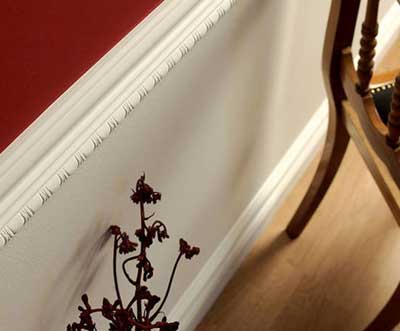Finishing stucco walls today are very popular, as to give the room stood and noble appearance. This interior design transforms not only the ceiling and walls, but also to decorate fireplaces, doors and windows in the house. At the same soft lines stucco design allow hide irregularities highlight the beauty of lighting and furniture.
Content
Decorative trim moldings using
The main advantage of decorative moldings on the walls is its combination of different directions and styles, ranging from timeless classics to contemporary minimalism.
Thanks to a special technique of molding and asymmetric order of elements, stucco able to hide many surface defects, a close communication, and gracefulness make the most usual niche in the wall.
Today a wide demand among such ornaments purchased stucco curbs, pedestals and pilasters brackets and dome, stands for bar and bookshelves. In this case, instead of the curb to the ceiling gourmets prefer to use decorative moldings, which gives solemnity and refinement of the interior.
Materials for the manufacture of stucco
Lepunina can consist of wood, artificial polymers and plaster. As for the first species, it is an eco-friendly and fairly expensive building material. The latter is also good, but it is difficult to install it. Thus, modern types of plastic remains - polystyrene and polyurethane.
So what is better? Polyurethane is significantly cheaper than polystyrene and serves to 30 years, while the second quickly loses its appearance. If you take care of your own health, then the variant of the stucco from polyurethane will meet all the requirements and differ hypoallergenia. At the same time, such products are known for their clear drawing, they can be laminate and rejected by a water-emulsion.
Gypsum - material, which, when frozen, expands and under pressure penetrates the smallest embossed recesses, which adds to him special advantages. Thanks to this property, designers can incarnate the most exquisite fantasies and convert an existing interior into an exclusive place to relax.
How to make stucco on the wall
Production of plaster stucco on the wall with their own hands is a very exciting process. For her you will need: Knife, scalpel, shape, wire and building gypsum. The latter is the basis of the future product, since it is able to take any forms, felting in work and quickly freezes.
To use gypsum in the modeling, it is initially pouring into water and stir well. So you will get the material to create a decor. In this case, its coolness should depend on how massive will be the finished product. What it is more, the thick should turn out the dough.
A complex stucco must be done on a copper wire frame, since it is longer and flexible:
- first prepares design for the desired element, which is then filled with a plaster test;
- after its partial froze, the molding of the details occurs.
Recommendations:
- due to the fact that the gypsum dries quickly, it is necessary to have skills to create such products, or use simple small elements;
- if you wish to connect several parts, it should be attached to each other with a gypsum test;
- to make a stucco defined texture and color, you can use various pigments and additives.
After the material is frozen, the gypsum stucco is polished with a shallow grain shaft. Due to this, the sideline will acquire a matte smooth surface.
If you are not the owner of good ability to model, then you can buy a ready-made form for stucco, which is sold in a specialized store. It is a silicone or plastic mold, a combination of which allows to realize the most exquisite fantasy.
Mounting plaster stucco
In order for everything to be sustained in one style, experts recommend repeating patterns on the ceiling and walls. However, the main thing here is not to overdo it, since the appearance of visual decrease in space is possible. It should not be used heavy molding elements in small rooms that are able to create an impression of inappropriateness and artificiality.
Recommendations:
- decter to where the decor will be located, considering the dimensions of the apartment;
- volumetric items should be reliably fixed, thoroughly observing the fastener technique with screws and dowels;
- before proceeding with the mounting process, rinse well the desired place and completely remove the whitelle;
- then make the edge boundary with a pencil;
- on the product, ceiling and wall make notches with a chisel;
- if you install the cornice, you need to start with the angle. With hacksaw cut the stucco at an angle of 45 ° to 2 elements;
- next, we prepare a gypsum solution with the addition of 3% carbon adhesive or apply a special glue;
- we wat the surface of the wall with water and apply an adhesive mixture on it;
- install the item to the desired place, slightly navigating it;
- surplus gypsum We remove the shovel for plaster.
If the elements of the eaves are quite large, it should be attached to the screws:
- initially, it is necessary to make a hole in the wall;
- then drive the plugs in them and only then screw the screws;
- further opposite the screws, on the back side of the eaves, the walls create holes that are slightly expanded into depth. They must be filled with plaster and plant the product on the fastener details.
Fixing sockets:
- make through holes in the outlet that should be located opposite the plugs with screws in the ceiling;
- to each screw, screw the soft wire, which in advance should be covered with nitroloma;
- cut through the wires through the holes and screw the screws;
- holes to smear the plaster.
How to make stucco on your own video:

































I saw the mass of lessons, I dumped out the shape, did the solution, but I didn't go anything like that) that is, it turned out, but it was clear something wrong) probably still easier to buy))
The gallery of work they have an interesting